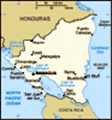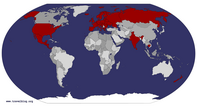Advertisement
Published: January 30th 2006
An hour into Nicaragua and we came across our first problem - no bridge. We were attempting to satisfy the latest phase of Rachel's seemingly insatiable appetite for all things "local" and "crafty", by visiting a pottery co-operative in the village of Ducuale Grande. After a few miles of dirt road we saw the remains of what was once the only safe way to cross the river, until the fringes of hurricane Stan had played with it. The only way was to ford so I took all the necessary precautions that any self respecting over-lander would; asked the locals where best to cross, checked the entry and exit points, checked the flow rate, estimated the depth...finally I suggested that the vehicle behind us should go first.
The pottery was an interesting place where a number of the local women combine their talents and produce traditional red-clay pieces for sale in their small store. We bought something, not sure what it is, or does, but Rachel seems to like it.
In order to acclimatise to the Nicaraguan way of life, we spent the first couple of nights in Esteli, the main town of Nicaragua's Northern Highlands where some buildings still
sport bullet holes as scars of the 1978-79 Sandanista revolution. You soon understand that it is cheaper to travel in this country than in most of its neighbours, perhaps just as quickly you notice that poverty is a lot more evident; there are many parallels with Cambodia, which we enjoyed so much.
The weather was miserable when we headed back up the Pan-American Highway to find the turn-off for San Juan de Limay, a small town famous for its soapstone carvings. This was a long drive, partly due to the rough road but also because, on several occasions, we became part of a herd of cows, from which there was no escape...until the cows decided it was time. There are no shops as such, you just have to pop between the homes of the sculptors to view their art. The first house we visited turned out to be the best we could find, the sculptor's family entertained us while he made the finishing touches to our chosen piece, and then we chatted about the best way to get to Leon, where we intended to stay that night. We'd heard of a rough road via the town of El Sauce
that sounded interesting but our new friends told us that we absolutely, positively, should not go on that road, it was too dangerous and had claimed the lives of three Costa Ricans last year...
...red rag to a bull...or a couple of bulls.
Actually, that's not strictly true, we fully intended to heed the advice we were given, the problem was...we took the wrong turning. It was, roughly, twenty miles of crawling over bare rock and thick mud, through streams and over deep ruts, quite often with canyons to one side that the car would decide to slide towards uncontrollably. I had a brief chat with a motorcyclist who was surprised to see us and even more surprised when we told him that we'd come from San Juan. He'd had to wait while I tried to encourage our car to continue in a straight line and not take us for a swim in the lake, he estimated only one vehicle per fortnight making the same journey...we made a mental note to double check directions in future. After nearly four hours we'd made it, but not to Leon.
El Sauce; exhausted, we decided to stay here and pulled
into the first guesthouse we saw - it was probably the only one. The owner recommended somewhere to eat which turned out to be someone's house with a barbecue on the pavement...the food was fantastic, you're choice of meat with salad, plantains, a home made nuclear picante and Nicaragua's famous gallo pinto - typical local fare. The next day we woke up to the sound of marching bands celebrating the town's centenary (this was something we quickly got used to while travelling through the country as, it seemed, every town was celebrating something, or rehearsing the celebration of something, while we were there).
On our way to Leon we stopped off at the bubbling mud pools of San Jacinto, ably assisted by a ten-year-old girl as a guide who just seemed to keep repeating the words "hot" and "dangerous". In Nicaragua the Pan-American highway is very good, most of the other roads are very bad, and after finally arriving in Leon we met a man with a job that is guaranteed to last him a lifetime; photographing the sorry state of the country's roads and reporting his findings to the Government. This man was typical of the Nicaraguan people,
while we were enthusiastically reciting our off-road stories he was apologising for the state of the roads, ever keen to impress they seem to beam with pride when you tell them how much you are enjoying their country.
Leon is another of those classic colonial towns that are dotted around Mexico and Central America, it's a University town dominated by the enormous cathedral, Basilica de la Asunción, and ornate churches on every other block. The highlight of our stay here was being allowed to wander around on the roof of the cathedral - with views of the Los Maribios volcanic chain in the distance. Leon is famous as the birth town of the 19th century poet Rubén Darío, who is celebrated by all Latin American countries so we visited the museum in his original house to see a great collection of furniture, personal belongings, books and tributes from all over the Spanish speaking world, there are no English translations in this museum but it seems the better for it; anyway, after four months or so we're almost conversational in Spanish - right up to the point where we have to speak.
We pushed on to the capital, Managua,
and then pushed on again, quickly. We just didn't get a good feeling from the city, not that it felt dangerous, it just didn't seem to have a great deal to offer. A girl we met a week or so later recalled arriving there and, within ten minutes, having all her belongings stolen at gunpoint.
Masaya, a lot smaller and more laid back, is just a half an hour further South, it's the craft centre of Nicaragua, apparently, which doesn't mean a great deal to me but tends to fix a manic expression on Rachel's face, its also very close to a handful of other artisans' villages. So we looked at a load of crafts and pottery, which was nice. Another quick side trip to see the Parque Nacional Volcán Masaya and the Santiago crater of Volcán Masaya, constantly belching out thick plumes of sulphurous gases in it's quest to beat Costa Rica's Arenal and become the region's most active, then we were on our way to Granada.
We
were on our way, but while filling up with petrol we spotted a fortress of some kind on a hill above Masaya, the petrol attendant told us what we
needed to know and we were soon at the top of the steep approach road and in the middle of the fort. Coyotepe, or the hill of the wolves, is now a Boy Scout clubhouse, but it once had a far more sinister role. Renee basically lives in the fortress as a caretaker and offered to show us around. Originally used by the Somozistas as a place to imprison and torture captured Sandanista rebels, following the revolution the guards became prisoners themselves, receiving no less brutal treatment by vengeful former prisoners and their allies. It has remained unchanged since its abandonment in 1984, save some graffiti and looting you can imagine the conditions in which prisoners were kept, some 24 to a cell and mostly without light, the torture and execution rooms are still evident. This was one of the best tours we've had, with Renee proving to be the perfect guide - we spent the hours drive to Granada trying to memorise everything he had said.
Something bad happened in Granada, we returned to our hotel on the first afternoon to find a man cleaning our car, this was the first time it had looked like its original
white colour since we bought it, all of that hard work getting mud on the roof. Begrudgingly I gave him a few Cordobas for his efforts; this was way over the odds or he thought me stupid, or both, because the very next day he was back cleaning it again - it hadn't even moved. Granada is an excellent colonial town, founded in 1542 its situated on the northern shores of Lake Nicaragua, it is just as good as the Antiguas and San Cristóbals of this world and, just like its Northern cousins, it has thrived recently on its popularity with gringo ex-pats and an explosion of language schools. Woken up each morning by band and parade practices, the day we decided to leave coincided with a huge parade through the town, as in the rest of Nicaragua, and all of Central America this consists of a parade of scantily clad teenage girls followed by a band of what seems like two trumpeters and three hundred drummers - they're colourful and loud. The American owner of a local restaurant had no idea what it was about, "...they're always celebrating some s**t or other."
We paid a visit to the
beautiful Lago de Apoyo and the nearby villages of San Juan de Oriente and Catarina and then headed south along the shores of the vast Lake Nicaragua. We had planned to visit Isla Omotepe, the largest lake island in the world, but poor weather was forecast for a couple of days so we saw little point in making the ferry crossing. Three days on the Pacific coast at San Juan del Sur, which had the same grey weather. It also had Karen and Roy from California who are building a resort in a neighbouring village and, more importantly, were highly entertaining and share our lack of control where alcohol is concerned. Our last day saw fine weather so the four of us visited the local "Da Flying Frog" canopy tour, Roy wanted to check it out on behalf of his future clients and we all saw it as good self-punishment for drinking too much. With the recent rains the trip to the start of the tour was impossible by vehicle, even with the former army truck that they picked us up in, so we had the added bonus of a horse ride to the top. Let it be known that
I'm not fond of horses, they just don't seem to have the same respect for me that, say, a motorcycle does; this was only my second attempt, the first was on a stunted pony in the Andes, who's legs were shorter than mine. However, the guides saw fit to give me a proper horse this time, one that worked. The views of the coast from the start of the tour were spectacular, and the canopy tour itself was excellent, with seventeen platforms it crossed over a huge area of rainforest and several waterfalls, even Rachel enjoyed it - despite her fear of heights.
From San Juan del Sur it was just a short drive to the unfortunately named border town of Peñas Blancas and after minimal formalities we were in Costa Rica.
Advertisement
Tot: 0.261s; Tpl: 0.018s; cc: 10; qc: 61; dbt: 0.0542s; 1; m:domysql w:travelblog (10.17.0.13); sld: 1;
; mem: 1.2mb

















